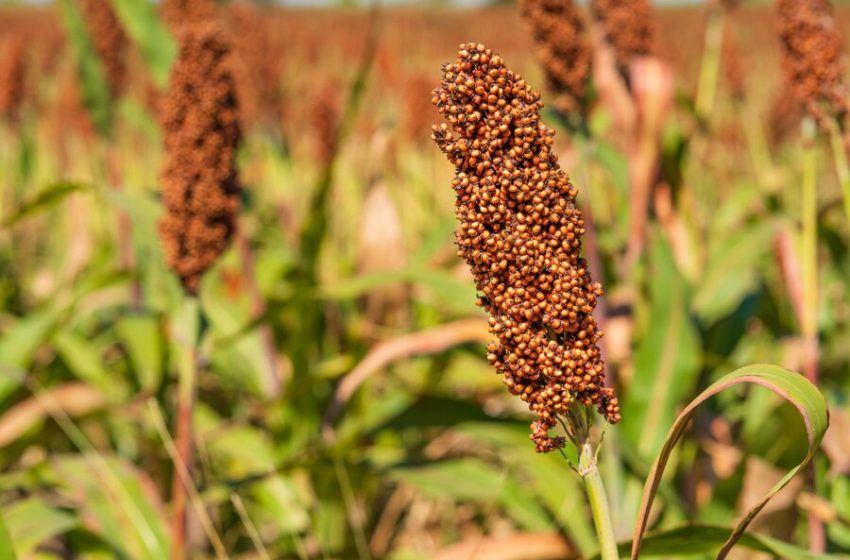The Secrets to Successful Sorghum Cultivation

Sorghum is a tough and versatile crop grown in tropical and temperate environments. It is an important meal that provides millions of people with vital nutrients in numerous countries. Sorghum is also used as animal feed, biofuel, and beer.
Farmers prefer this crop because it grows in dry environments and requires less water than other grains. Furthermore, sorghum adds organic matter to the soil, which enhances its health. In dry areas, sorghum provides food security because of its drought resistance.
This blog will walk you through the process of cultivating sorghum, including the preparation of the land and climatic requirements.
Facts And Figures About Sorghum in Worldwide
The fifth-most valuable cereal crop in the world is sorghum. Globally, it occupies more than 42 million hectares. The top three countries that produce sorghum are the United States, Nigeria, and India. The output of sorghum reached 61.5 million tonnes worldwide in 2023.
In developed nations specifically, about 40% of sorghum is used as animal feed. Sorghum is an everyday diet for millions of people in Africa. Furthermore, sorghum grows well in dry areas because of its tolerance to drought.
This crop promotes economic expansion, particularly in underdeveloped countries. The production of biofuel from sorghum has grown dramatically in recent years, bringing a global contribution to renewable energy options.
In the next sections, we will discuss the cultivation process of the Sorghum crop.
Cultivation Process
There are several steps in the cultivation process of sorghum. We are going to understand each and every step in detail below:
Perfect Climate Conditions
Sorghum grows well in warm areas, with the perfect temperature ranging from 25°C to 30°C. It grows in dry and semi-arid environments because of its high resistance to drought. 400–600 mm of rainfall is necessary for sorghum development. However, heavy rain can damage crops; therefore, proper drainage is essential.
Furthermore, sorghum needs bright weather for the best photosynthesis. It also tolerates heat, but winter can harm its development and productivity. Therefore, conditions free of frost are essential for productive farming.
Land Preparation
The first step in preparing land for sorghum is to remove any weeds and waste. Then, plough the ground down to a depth of 15 to 20 cm. This promotes better aeration and loosens the soil.
Farmers can use powerful tractors, like Mahindra Tractor, for better ploughing. Preet tractors are popular for their strong engines and offer tractors ranging from 20 HP to 100 HP.
Level the land after ploughing to provide uniform water distribution. Add compost or organic materials to improve soil fertility. Lastly, prepare the seedbeds for planting by spacing them appropriately. Proper land preparation promotes higher seed germination and healthier sorghum plants.
Varieties of Sorghum
There are several types of sorghum, and each is suitable for a particular use. For example, sorghum is great for food and animal feed. Syrups and biofuels are made from sweet sorghum grain. Additionally, grass sorghum makes high-quality animal feed. Sorghum popping is another well-liked snack.
Select varieties according to local circumstances and your particular demands. Every variety has special qualities, such as resilience to drought or high yield. Choosing the appropriate variety enhances agricultural output and performance overall.
Planting
Sorghum planting involves selecting good-quality seeds and soil to plant in. Sow the seeds when the soil gets to specific temperatures of about 20 degrees Celsius. Sow the seeds 2 to 5 cm deep and leave 20 to 30 cm between plants. All the rows should be 60-75 cm apart so that there will be ease in the cultivation process.
Irrigate the field slightly after planting to help with the germination of the seeds. Furthermore, there is a tendency to moisten, which is harmful to the seeds. Crop monitoring of the field in terms of proper growth and the need to control weeds should also be done from time to time.
Irrigation Practice
Sorghum crops generally require a moderate amount of water especially when there is dry weather. Begin watering after placing the seeds so that the seeds may grow. Fertilize the field in the spring, and water it more frequently, about once in every 10-15 days depending on the ground condition.
Apply water in the most efficient way possible, such as using drip or sprinkler systems. Further, do not water your plants too much to avoid root rot and similar diseases.
Pest Management.
Pest Management
Pest control that works is essential to a healthy sorghum crop. Aphids, flies, and sorghum midge are common pests. Examine fields for pests on a regular basis to control them. For natural pest reduction, use biological control techniques such as beneficial insects. Apply pesticides as well when pest populations become out of control.
Crop rotation helps keep pests from building up in the soil. These strategies are successfully combined when integrated pest control is implemented. Controlling pests effectively promotes crop health and greatly boosts sorghum production.
Harvesting
Sorghum harvesting starts when the grains become firm and golden in colour. For efficiency and speed, harvest sorghum with a Mini Tractor. For maximum grain collection, cut the crop close to the ground. To prevent it from spoiling, make sure the moisture content is about 15%. Give the grains a thorough cleaning to remove dirt and contaminants. To preserve quality, keep the collected grains cold and dry.
Conclusion
Globally, sorghum farming is essential to sustainable agriculture. It is perfect for dry areas due to its tolerance to drought, guaranteeing food security. Sorghum produces well and may be used in a variety of ways with careful soil preparation and insect control. Farming efficiency is increased by using effective equipment like Preet harvesters and tractors. Growing demand for sustainable crops has kept sorghum at the top of farmers’ lists. By understanding its cultivation method, we may guarantee a bright future for agriculture.

